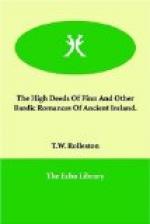When we come to the Fenian cycle there is a well-defined borderland between them and Christianity. The bulk of the stories is plainly pagan; their originals were frankly so. But the temper of their composers is more civilized than that of those who conceived the tales of the previous cycles; the manners, as I have already said, of their personages are gentler, more chivalrous; and their atmosphere is so much nearer to that of Christianity, that the new Christian elements would find themselves more at home in them than in the terrible vengeance of Lugh, the savage brutality of Conor to Deirdre, or the raging slaughterings of Cuchulain. So much was this the case that a story was skilfully invented which linked in imagination the Fenian cycle to a Christianized Ireland. This story—Oisin in the Land of Youth—is contained in this book. Oisin, or Ossian, the son of Finn, in an enchanted story, lives for 300 years, always young, with his love in Tir-na-n-Og, and finds on his return, when he becomes a withered old man, St Patrick and Christianity in Ireland. He tells to Patrick many tales of the Fenian wars and loves and glories, and in the course of them paganism and Christianity are contrasted and intermingled. A certain sympathy with the pagan ideas of honour and courage and love enters into the talk of Patrick and the monks, and softens their pious austerity. On the other hand, the Fenian legends are gentled and influenced by the Christian elements, in spite of the scorn with which Oisin treats the rigid condemnation of his companions and of Finn to the Christian hell, and the ascetic and unwarlike life of the monks.[4] There was evidently in the Fenian cycle of story-telling a transition period in which the bards ran Christianity and paganism in and out of one another, and mingled the atmosphere of both, and to that period the last editing of the story of Lir and his Children may be referred. A lovely story in this book, put into fine form by Mr Rolleston, is as it were an image of this transition time—the story or How Ethne quitted Fairyland. It takes us back to the most ancient cycle, for it tells of the great gods Angus and Mananan, and then of how they became, after their conquest by the race who live in the second cycle, the invisible dwellers in a Fairy country of their own during the Fenian period, and, afterwards, when Patrick and the monks had overcome paganism. Thus it mingles together elements from all the periods. The mention of the great caldron and the swine which always renew their food is purely mythological. The cows which come from the Holy Land are Christian. Ethne herself is born in the house of a pagan god who has become a Fairy King, but loses her fairy nature and becomes human; and the reason given for this is an interesting piece of psychology which would never have occurred to a pagan world. She herself is a transition maiden, and, suddenly finding herself outside the fairy world and lost, happens on a monastery and dies on the breast




